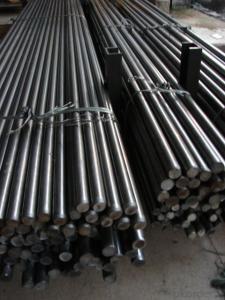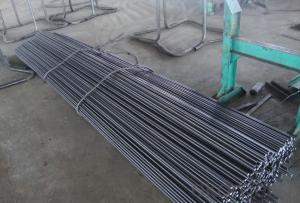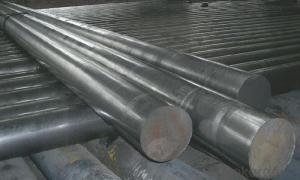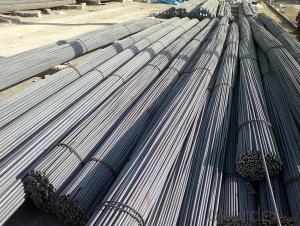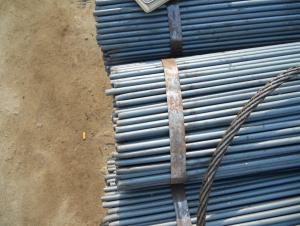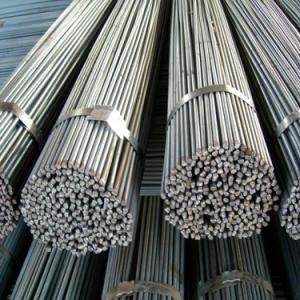Cold Drawn Steel Round Bar with High Quality-75mm
- Loading Port:
- China Main Port
- Payment Terms:
- TT or LC
- Min Order Qty:
- 100 m.t
- Supply Capability:
- 10000 m.t/month
OKorder Service Pledge
OKorder Financial Service
You Might Also Like
Cold Drawn Steel Round Bar with High Quality-75mm
Product Description:
Specifications:
1.Size: 75mm
2.Material: AISI 1045/DIN 1.1191/JIS S45C/GB 45
3.Chemical analysis:
C | Si | Mn | P≤ | S≤ | Cr |
0.40~0.60 | 0.20~0.30 | 0.70~0.90 | 0.030 | 0.030 | 0.01~0.03 |
4.Process: EAF + LF + VD + Forged + Heat Treatment (optional)
5.Delivery condition:Hot forged +Rough machined (black surface after Q/T)+ Turned (optional)
6.Technical Data: Chemical Composition, Physical Properties and Mechanical Testing.
7. Test: Ultrasonic test according to SEP 1921-84 3C/c.
8. Standard: GB, AISI, ASTM, DIN, JIS, BS, etc.
9. Quality Management Certification: ISO 9001:2008.
10. Main application:
(1)It is widely used in machinery manufacturing.
(2) For the manufacture of high strength requirements parts, such as gears, shafts, piston pin and the uneven force big machining parts, forgings, stampings and bolts, nuts, pipe joint.
FAQ of Cold Drawn Steel Round Bar with High Quality-75mm:
Q1: How soon can we receive the product after purchasement?
A1: Within three days of placing an order, we will begin production. The specific shipping date is dependent upon international and government factors, but is typically one month.
Q2: How do you guarantee the quality of our products?
A2: We have established an advanced quality management system which conducts strict quality tests at every step, from raw materials to the final product. At the same time, we provide extensive follow-up service assurances as required.
Q3: The prices are invoicing on theoritical weight or on actual weight?
A3: We can do it in both manners, according to the customers' request.
Images of Cold Drawn Steel Round Bar with High Quality-75mm:
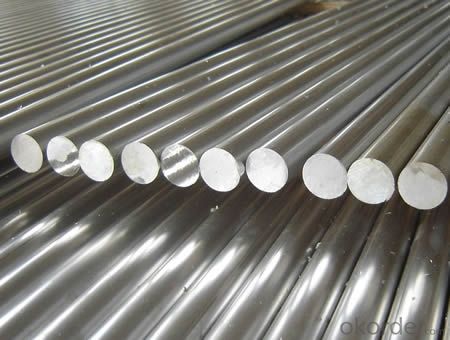

- Q:How do steel round bars compare to carbon fiber round bars?
- Steel round bars and carbon fiber round bars are two different materials commonly used in various industries. Here is how they compare: Strength and Durability: Steel round bars are known for their exceptional strength and durability. They can withstand heavy loads, high temperatures, and harsh environments. Carbon fiber round bars, on the other hand, are also strong but are generally not as strong as steel bars. However, carbon fiber bars excel in terms of strength-to-weight ratio, making them a popular choice for applications where weight reduction is crucial. Weight: Steel round bars are significantly heavier than carbon fiber round bars. This weight difference often makes carbon fiber bars preferable in industries where weight reduction is important, such as aerospace and automotive sectors. Lighter bars can contribute to improved fuel efficiency, increased speed, and enhanced maneuverability. Corrosion Resistance: Steel round bars are prone to corrosion, especially when exposed to moisture and certain chemicals. Regular maintenance and protective coatings are often required to prevent rusting. On the other hand, carbon fiber round bars are inherently corrosion-resistant. This property makes carbon fiber bars valuable in environments where corrosion can be a concern, such as marine applications. Flexibility and Stiffness: Steel round bars are generally stiffer and less flexible compared to carbon fiber round bars. This characteristic can be advantageous in applications where rigidity and structural integrity are crucial, such as construction and heavy machinery. Carbon fiber round bars, on the other hand, offer higher flexibility and can be engineered to have different levels of stiffness, making them suitable for applications that require vibration damping or enhanced shock absorption. Cost: Steel round bars are generally more cost-effective compared to carbon fiber round bars. Steel is a widely available material, and its production costs are relatively low. Carbon fiber, on the other hand, is more expensive to produce due to the complex manufacturing process and the cost of raw materials. As a result, carbon fiber round bars tend to be pricier, limiting their use to industries where their unique properties justify the increased costs. In conclusion, steel round bars and carbon fiber round bars have their own advantages and disadvantages. Steel bars offer exceptional strength, durability, and cost-effectiveness, while carbon fiber bars excel in terms of weight reduction, corrosion resistance, flexibility, and stiffness. The choice between the two depends on the specific requirements of the application, including factors such as load-bearing capacity, weight reduction, corrosion resistance, and cost considerations.
- Q:Can steel round bars be used for making sculptures?
- Yes, steel round bars can be used for making sculptures. Steel is a versatile and durable material that can be manipulated into various forms and shapes. Round bars are particularly suitable for creating sculptures that require a smooth and curved aesthetic. Steel sculptures are known for their strength, longevity, and ability to withstand different weather conditions, making them suitable for both indoor and outdoor installations. Additionally, steel can be welded, bent, and shaped easily, allowing artists to explore their creativity and create intricate designs. With proper techniques and skills, steel round bars can be transformed into stunning sculptures that can add a modern and industrial touch to any space.
- Q:Can steel round bars be used for structural purposes?
- Yes, steel round bars can be used for structural purposes. Round bars are commonly used in construction and engineering projects for their strength and durability. They can be used as load-bearing members in buildings, bridges, and other structures, providing support and stability. Steel round bars are available in various grades and sizes, allowing for versatility in design and application. They can be easily welded, formed, and machined to meet specific project requirements, making them a popular choice for structural applications.
- Q:What are the different types of steel round bars used in the defense industry?
- In the defense industry, various steel round bars are commonly employed due to their strength, durability, and ability to withstand harsh conditions. Some of the frequently utilized types are as follows: 1. High-strength low-alloy (HSLA) steel round bars: These bars possess a high strength-to-weight ratio, making them ideal for applications where weight reduction is crucial. They find extensive use in the construction of armored vehicles, tanks, and other military equipment. 2. Stainless steel round bars: Stainless steel exhibits remarkable resistance to corrosion and rust, making it an excellent choice for defense applications exposed to moisture or harsh environments. Its wide usage includes the manufacturing of military aircraft, naval vessels, and firearms. 3. Carbon steel round bars: Carbon steel is a versatile and cost-effective material extensively used in the defense industry. It offers excellent strength and hardness, making it suitable for various applications, such as missile components, gun barrels, and armor plates. 4. Alloy steel round bars: Alloy steel is a blend of different metals, typically including chromium, molybdenum, and nickel, which enhances its mechanical properties. It finds common application in the production of military-grade vehicles, artillery systems, and munitions. 5. Tool steel round bars: Tool steel is specifically designed to possess exceptional hardness, wear resistance, and toughness. It is often employed in the manufacturing of cutting tools, drills, and other equipment utilized in the defense industry. Each type of steel round bar possesses unique properties and advantages, enabling it to meet specific requirements within the defense sector. The selection of the appropriate steel round bar depends on the specific application and the desired performance characteristics needed to meet the demands of the defense industry.
- Q:Are steel round bars resistant to fire?
- With their high resistance to fire, steel round bars exhibit exceptional fire-resistant properties owing to their high melting point and low thermal conductivity. In the occurrence of a fire, steel round bars do not readily ignite or combust. Moreover, steel maintains its structural integrity even under extreme temperatures, rendering it a favored selection for construction materials in areas susceptible to fires. As a result, steel round bars prove to be a dependable and secure choice for a range of applications, encompassing building structures, industrial equipment, and fire-resistant barriers.
- Q:What are the different cutting methods used for steel round bars?
- There are several cutting methods commonly used for steel round bars, including abrasive cutting, cold saw cutting, band saw cutting, and plasma cutting. Each method has its own advantages and suitability depending on factors such as the required precision, speed, and cost-effectiveness of the cutting process.
- Q:What is the mechanical properties of No. 40 round bar?
- There are 20 kinds of steel classification: carbon steel, alloy steel, carbon structural steel, special purpose and so on. Look at the questions this afternoon and find out about the books. Which type of steel do you ask? This is not clear, I gave up the answer, and then I see your this question.
- Q:How do you measure the straightness tolerance of a steel round bar?
- To determine the straightness tolerance of a steel round bar, various methods can be employed based on the desired level of accuracy and precision. Below are several commonly used techniques: 1. Visual Inspection: This straightforward approach involves visually examining the bar for any noticeable deviations from straightness. Placing the bar on a flat surface allows for the detection of bends or curves along its length. However, it is worth noting that this method is subjective and may not yield precise measurements. 2. Straightedge Method: Using a straightedge such as a ruler or precision straightedge, one can assess the presence of gaps or spaces between the straightedge and the bar's surface. This method offers a higher level of accuracy but can still be influenced by human error. 3. Dial Indicator Method: By utilizing a dial indicator, a precise measuring tool, the straightness tolerance can be measured. Fixing the dial indicator to a stationary point and moving it along the length of the bar enables the identification of any deviations from a straight line. This method provides more precise measurements and can quantify the straightness tolerance in specific units like inches or millimeters. 4. Laser Measurement: Laser systems, such as laser alignment devices, serve as an effective means of measuring the straightness tolerance of a steel round bar. These systems project a straight line onto the bar's surface using lasers and then analyze any deviations from this line. Laser measurement offers highly accurate and repeatable results, making it suitable for applications requiring strict tolerances. It is essential to consider the required level of accuracy, the size of the round bar, and the available resources and equipment when selecting a measurement method. It is also advisable to consult industry standards and guidelines to ensure compliance with specific tolerances and requirements relevant to your application.
- Q:What is the typical lead time for manufacturing steel round bars?
- The typical lead time for manufacturing steel round bars can vary depending on several factors, such as the quantity and size of the bars, the complexity of the manufacturing process, and the availability of raw materials. However, a general estimate for lead time could range from a few weeks to a couple of months. It is always best to consult with the specific manufacturer for an accurate timeframe.
- Q:Can steel round bars be used in the manufacturing of cylinders?
- Certainly, cylinders can be manufactured using steel round bars. Steel round bars are widely utilized across industries such as automotive, aerospace, and manufacturing owing to their exceptional strength and durability. When it comes to constructing the cylindrical body of a cylinder, steel round bars serve as an ideal material choice. The steel round bars can be shaped through machining, forging, or rolling, and subsequently joined together through welding or fastening to create the cylindrical structure. By employing steel round bars, the resulting construction guarantees robustness and stability, both of which are crucial for the secure and effective operation of cylinders in diverse applications.
1. Manufacturer Overview |
|
|---|---|
| Location | |
| Year Established | |
| Annual Output Value | |
| Main Markets | |
| Company Certifications | |
2. Manufacturer Certificates |
|
|---|---|
| a) Certification Name | |
| Range | |
| Reference | |
| Validity Period | |
3. Manufacturer Capability |
|
|---|---|
| a)Trade Capacity | |
| Nearest Port | |
| Export Percentage | |
| No.of Employees in Trade Department | |
| Language Spoken: | |
| b)Factory Information | |
| Factory Size: | |
| No. of Production Lines | |
| Contract Manufacturing | |
| Product Price Range | |
Send your message to us
Cold Drawn Steel Round Bar with High Quality-75mm
- Loading Port:
- China Main Port
- Payment Terms:
- TT or LC
- Min Order Qty:
- 100 m.t
- Supply Capability:
- 10000 m.t/month
OKorder Service Pledge
OKorder Financial Service
Similar products
New products
Hot products
Related keywords
